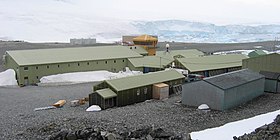Rothera
| Rothera Research Station | |||
|---|---|---|---|
| Research outpost | |||
 |
|||
|
|||
 The Rothera Research Station is located within the British Antarctic Territory in Antarctica |
|||
| Location of Rothera Research Station in Antarctica | |||
| Coordinates: 67°34′S 68°08′W / 67.567°S 68.133°WCoordinates: 67°34′S 68°08′W / 67.567°S 68.133°W | |||
| Country | United Kingdom | ||
| British Overseas Territory | British Antarctic Territory | ||
| Location in Antarctica | Adelaide Island | ||
| Administered by | British Antarctic Survey | ||
| Operational | 1975 | ||
| Population | |||
| • Total | 22 | ||
| Seasonal | |||
| Website | www |
||
| Summary | |||||||||||
|---|---|---|---|---|---|---|---|---|---|---|---|
| Serves | Rothera Research Station | ||||||||||
| Location | Antarctic Peninsula | ||||||||||
| Runways | |||||||||||
|
|||||||||||
The Rothera Research Station is a British Antarctic Survey (BAS) base on the Antarctic Peninsula, located at Rothera Point, Adelaide Island. Rothera also serves as the capital of the British Antarctic Territory, a British Overseas Territory.
Rothera station was established in 1975 to replace Adelaide station (1961-1977) where the skiway had deteriorated.
The opening of the Bonner Laboratory in 1996/1997 marked the start of new activities in biological sciences in the Antarctic peninsula. These included scuba diving and experiments conducted in the Bonner Laboratory throughout the year. The first Bonner Lab burned down in the winter of 2001 after an electrical fault; it was rebuilt and opened in December 2003. Meteorological research using satellite data intercepted at the Rothera ground station also continues year round.
In January 2017, it was announced that the Rothera Research Station will receive £100m in funding from the government. The money will be used by the British Antarctic Survey to build new living quarters, storage and a new wharf. Tim Stockings, its director of operations called the investment “an exciting moment for polar science”. A portion of the money will also be used to fund the modernisation of facilities and buildings at the British Antarctic stations in Signy, Bird Island and at King Edward Point.
Fieldwork is concentrated in the summer months from November until March. Once in the field, the parties travel using skidoos and sledges for up to four months, and, being in daily HF radio communication with Rothera, they can be resupplied when necessary by air.
The station is open throughout the year with a maximum population of 130 in the summer and an average winter population of 22.
In 1998, 26 sounding rockets of "Viper"-type were launched from Rothera Research Station. They reached altitudes of 100 kilometres (over 60 mi).
...
Wikipedia



